eyewinder
XS650 Enthusiast
As part of a brake system overhaul on my 1980 Special (caliper and rear master cylinder rebuilds + new stainless steel lines), I'm looking to replace the front master cylinder with a smaller bore model. This is my first motorcycle and since the brakes were shot when I purchased the bike, I have no point of reference as to how a working stock 14mm MC feels or functions.
I've read a ton of posts on this forum, reviewed the front master cylinder ratio chart (http://www.vintagebrake.com/mastercylinder.htm), and have talked to Michael Morse at 650Central about the switch to a smaller MC. However, I'm still left wondering about the actual lever 'feel' I can expect when everything is reassembled.
I'm looking for some objective comparisons between the stock and upgraded brakes, as the ratio 'sweet spot' appears to be partially related to personal preference.
Can anyone tell me the range of lever travel on a 14mm vs 11mm MC, assuming the same stainless lines are used? Put another way, what would be the distance from the lever to the bar when approaching wheel lock?
At the moment, I'm considering a 12mm Brembo MC from Bevel Heaven, as they also have a matching clutch lever (with mirror mounts on the clamps). Any insight would be greatly appreciated!
I've read a ton of posts on this forum, reviewed the front master cylinder ratio chart (http://www.vintagebrake.com/mastercylinder.htm), and have talked to Michael Morse at 650Central about the switch to a smaller MC. However, I'm still left wondering about the actual lever 'feel' I can expect when everything is reassembled.
I'm looking for some objective comparisons between the stock and upgraded brakes, as the ratio 'sweet spot' appears to be partially related to personal preference.
Can anyone tell me the range of lever travel on a 14mm vs 11mm MC, assuming the same stainless lines are used? Put another way, what would be the distance from the lever to the bar when approaching wheel lock?
At the moment, I'm considering a 12mm Brembo MC from Bevel Heaven, as they also have a matching clutch lever (with mirror mounts on the clamps). Any insight would be greatly appreciated!

